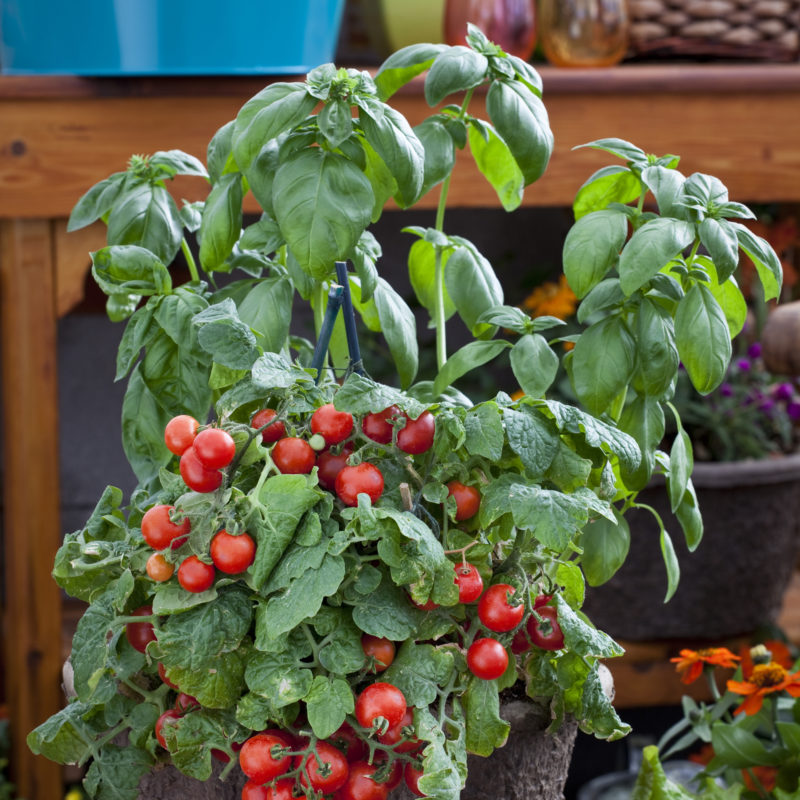A small garden space should not be a limiting factor! Sakata Home Grown wants to see veggie plants in every possible space and so we put together a list of themes and varieties to help.
Vegetable gardening has become a popular trend in recent years as consumers cut back on travel and dining out. Many people have turned to vegetable gardening as a leisure activity and a source for fresh, local produce to prepare at home. In addition, many parents are looking for ways to encourage their kids to spend time outdoors and find that a vegetable garden is a great family project (and a healthy activity for Mom & Dad as well). Many people have limited space and finances though so it is vital for those of us in the horticulture industry to make options available for everyone. A small garden space should not be a limiting factor once folks think outside the rows of a traditional vegetable garden. Sakata Home Grown wants to see veggie plants in every possible space and so we put together a list of themes and varieties to help.
Top Picks for Small Space Gardening
- Start with Tomatoes! Not just any variety will do for a small space. Many of the classic tomato varieties are huge sprawling plants that produce limited fruit. Offer early determinate types. Sweet Zen and Sweet Canary grapes, or Red Robin cherry, are early, compact and set fruit over several weeks. Offer Bella Rosa for full-sized fruit in just 70 days. All do well in large containers.
- Peppers pack a lot of fruit on one small plant. Jalafuego is early and productive. As one of the hottest jalapenos on the market, a few fruit go a long way. For folks looking for a milder heat, offer Cheyenne cayenne for fresh cooking or drying.
- For gardeners with a little more space be sure and offer some compact pumpkins and squash. Kids will love Rockafellow. Rockafellow pumpkin sets 2-3 lb pumpkins on a semi-determinate vine in about 95 days. Tivoli is another great choice. This medium-large AAS winning spaghetti squash has a bush habit (like a zucchini plant) and matures in 98 days.
- Don’t forget to recommend leafy greens. Even the smallest gardens can include a “cut and come again” leafy green garden space or container. Some of our favorite varieties to add color and texture to lettuce mixes include Bull’s Blood beet, Fordhook Giant Swiss chard, Santo cilantro, Vulcan lettuce and Topper turnip.
Notes for Growers
Tomatoes, peppers and squash are best sold in 4-inch or larger pots. Some shoppers might appreciate a larger container that they won’t have to transplant. For tomatoes and peppers, use 2-3 gallon-sized pots with good drainage. Half-wine barrels are great for two to three plants. Both tomatoes and peppers can be under-planted with edible flowers (such as nasturtiums), berries (like strawberries) or herbs (like oregano). Greens can be planted more closely and look lovely in 8-inch bulb pans or rectangular window-box planters. Be sure to vary height, texture and maturity to extend the life of the container.
Notes for Retailers
- Small space gardeners may not be used to buying vegetables so be sure to place some “grab and go” containers in high traffic areas. In addition to these containers, there should be some lower priced options, for example 4-inch pots that people can easily transplant on their own.
- Offer good care instructions, vegetables can require more care in small spaces than they would in a traditional garden setting. Place small watering cans and fertilizers nearby, these customers don’t need 25 pounds of compost or large irrigation systems. Gloves, small pruners and small baskets or colanders (for harvesting) are a nice touch.
- Recipes are a nice selling tool also for both experienced and new cooks. There are many great cookbooks available that highlight vegetables by season or region that can be an inspiration. Either sell the books or just set out a few store copies for people to peruse.
- Seasonality is very important to those looking for local produce, they strive to harvest at the optimal time of the year for the plant. This means you want to have plants in your store during the appropriate planting period for timely harvest in your area. For example, leafy greens are a popular fall crop on the West Coast, so small plants should be sold late July through September.
With a few exciting new plants and some different marketing techniques we can all get more people outside in the garden (and expand our customer base). New gardeners are great for our cities, the health of the population and the horticulture industry.
